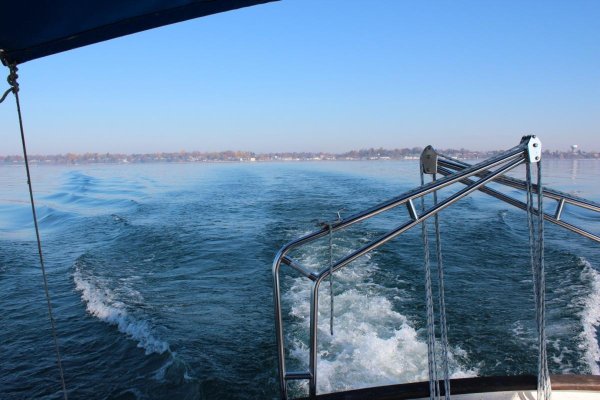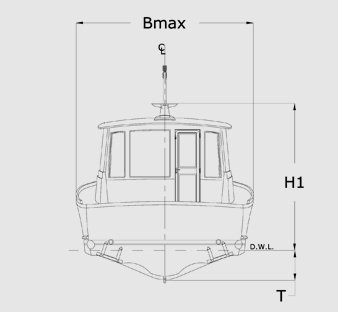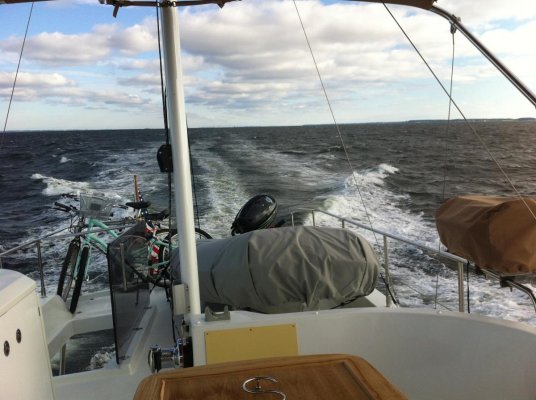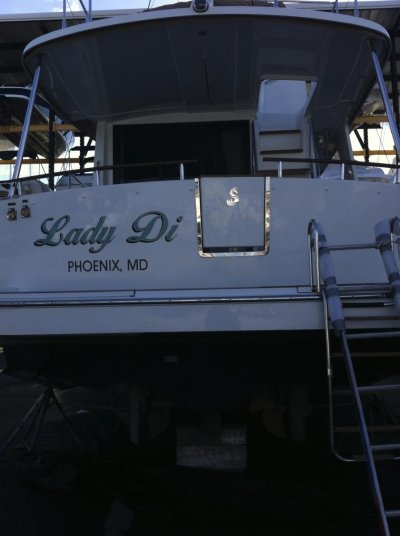You are using an out of date browser. It may not display this or other websites correctly.
You should upgrade or use an alternative browser.
You should upgrade or use an alternative browser.
How about a thread on fast or semi-displacement trawlers
- Thread starter LoneEagle
- Start date
The friendliest place on the web for anyone who enjoys boating.
If you have answers, please help by responding to the unanswered posts.
If you have answers, please help by responding to the unanswered posts.
Moonstruck
Guru
- Joined
- Nov 27, 2008
- Messages
- 8,276
- Location
- USA
- Vessel Name
- Moonstruck
- Vessel Make
- Sabre 42 Hardtop Express
Such as Benneteau, Sabreline, Mainship, etc.
Welcome Lone Eagle. Look for the search feature in one of the thin red lines above. Put in your search criteria, and look up most anything. There is a world of info in the archives including semi displacement hulls. You can also check the headings listed by boat manufacturers below.
If you want to start a new thread click on the new thread button, put in a heading, and post away.
How about telling us a little about your self and boating status. That is are you interested in buying a boat or have a boat. Things like that can help get you started. Sick around.
Edit: Just looked back and saw you have a Sabreline 36 near Annapolis. I happen to be partial to Sabres and Annapolis. Look for a private e-mail to show up in your mail box.
Last edited:
Well let me offer some thoughts to get the conversation started.
Fast, semi displacement trawlers (to use the trawler term loosely) are the norm today. Very few trawlers are round bottom pure displacement hulls. It is easier to note which are not semi displacement than those which are. Nordhavns, Krogens are two that are full displacement trawlers. Beneteaus, Mainships, Grand Banks, Sabres, Nordic Tugs, etc are all semi displacement.
Semi displacement hulls are able to go faster than displacement speed, but unlike planing hulls they really don't have a "hump" to get over. On the three semi displacement trawlers I have owned, it seems like there is a smooth, exponential relationship between power and speed.
Semi displacement hulls are less efficient than round bottom displacement hulls at displacement speeds. The angular lifting planes on a semi displacement hull just don't let water slide over them as easily as smooth round bottom displacement hulls. Where a displacement hull will take 1.5 hp per 1,000 lbs of hull weight to push it to displacement speed, a semi displacement hull takes 2.0-3.0 hp per 1,000 lbs.
Semi displacement hulls have big engines to push them to 10 kts and above. But can you safely run those big engines slow and cruise at or below displacement speeds?
The question is controversial, but I believe that if you run the engine at enough power loading to keep the cooling water and oil at operating temperatures then you will not do any damage. Coincidently that power level is just about the rpm and power setting needed to reach displacement speed.
So I run the 370 hp Yanmar in my Mainship Pilot 34 at 1,600 rpm and it goes about 7 kts, just below displacement speed. BTW the accepted definition of displacement speed is 1.34 * sqrt(water line length).
Weight becomes a big factor in semi-displacement hull efficiency, mostly because you are using a lot more fuel than a displacement hull at all speeds and much more fuel the faster you go.
It is interesting to note the differences in a low cost, mass produced trawler like the Mainship Pilot 34 and a high end one like a MJM 34. The Mainship claims that the Pilot 34 weighs 15,000 lbs and the MJM claims that their 34Z weighs 10,600 lbs. The difference if is is real is mostly due to fiberglass layup techniques. MJM claims that their 34Z uses 30% less fuel than their competitors and I can believe it if their weight is correct.
Semi displacement trawlers come in several hull types: classic flybridge models like the Grand Banks; pilot house, tug style like the Nordic Tug and downeaster style hardtops like the Mainship Pilot 34. And lots of variations in between.
So, that is a lot of info and maybe it will spark some discussion.
David
Fast, semi displacement trawlers (to use the trawler term loosely) are the norm today. Very few trawlers are round bottom pure displacement hulls. It is easier to note which are not semi displacement than those which are. Nordhavns, Krogens are two that are full displacement trawlers. Beneteaus, Mainships, Grand Banks, Sabres, Nordic Tugs, etc are all semi displacement.
Semi displacement hulls are able to go faster than displacement speed, but unlike planing hulls they really don't have a "hump" to get over. On the three semi displacement trawlers I have owned, it seems like there is a smooth, exponential relationship between power and speed.
Semi displacement hulls are less efficient than round bottom displacement hulls at displacement speeds. The angular lifting planes on a semi displacement hull just don't let water slide over them as easily as smooth round bottom displacement hulls. Where a displacement hull will take 1.5 hp per 1,000 lbs of hull weight to push it to displacement speed, a semi displacement hull takes 2.0-3.0 hp per 1,000 lbs.
Semi displacement hulls have big engines to push them to 10 kts and above. But can you safely run those big engines slow and cruise at or below displacement speeds?
The question is controversial, but I believe that if you run the engine at enough power loading to keep the cooling water and oil at operating temperatures then you will not do any damage. Coincidently that power level is just about the rpm and power setting needed to reach displacement speed.
So I run the 370 hp Yanmar in my Mainship Pilot 34 at 1,600 rpm and it goes about 7 kts, just below displacement speed. BTW the accepted definition of displacement speed is 1.34 * sqrt(water line length).
Weight becomes a big factor in semi-displacement hull efficiency, mostly because you are using a lot more fuel than a displacement hull at all speeds and much more fuel the faster you go.
It is interesting to note the differences in a low cost, mass produced trawler like the Mainship Pilot 34 and a high end one like a MJM 34. The Mainship claims that the Pilot 34 weighs 15,000 lbs and the MJM claims that their 34Z weighs 10,600 lbs. The difference if is is real is mostly due to fiberglass layup techniques. MJM claims that their 34Z uses 30% less fuel than their competitors and I can believe it if their weight is correct.
Semi displacement trawlers come in several hull types: classic flybridge models like the Grand Banks; pilot house, tug style like the Nordic Tug and downeaster style hardtops like the Mainship Pilot 34. And lots of variations in between.
So, that is a lot of info and maybe it will spark some discussion.
David
Codger2
Guru
- Joined
- Oct 11, 2007
- Messages
- 6,691
- Location
- US
- Vessel Name
- Circuit Breaker
- Vessel Make
- 2021..22' Duffy Cuddy cabin
So I run the 370 hp Yanmar in my Mainship Pilot 34 at 1,600 rpm and it goes about 7 kts, just below displacement speed.
David
I've always been interested in the performance of the Mainship 34 Pilot. Would you please list some of the performance specs such as:
High cruise speed
WOT Speed
Fuel flow at Those Speeds, etc
I'm interested in the single engine specs but either or both would be nice.
Moonstruck
Guru
- Joined
- Nov 27, 2008
- Messages
- 8,276
- Location
- USA
- Vessel Name
- Moonstruck
- Vessel Make
- Sabre 42 Hardtop Express
I've always been interested in the performance of the Mainship 34 Pilot. Would you please list some of the performance specs such as:
High cruise speed
WOT Speed
Fuel flow at Those Speeds, etc
I'm interested in the single engine specs but either or both would be nice.
Walt, I have info on my 2004 Pilot 34. David will have info on his.
I could cruise at 16 knots ang get 1.87 statute miles per gal. I figured in statute miles because the ICW is marked in statute miles. So I could really get an accurate reading. I did some long legged cruising with it. These are approx miles, but i could run from Hilton Head about mile 575 ti Swansboro, NC at about mile 230 or so on one fill up. That is at the 26 knots. You can convert statute to nautical miles for that figure. It was a great little cruiser.
Walt:
With the Yanmar 6LY-STP 370 hp engine, my Mainship Pilot 34 will top out at 20 kts and high cruise at 2,800 rpm and 15 kts. Both were measured with two way GPS speeds, 1/2 fuel and water, very clean bottom and two persons on board. I don't have measured fuel consumption, but Yanmar's prop curve indicates about 12 gph at 2,800 rpm which I suspect is pretty close.
David
With the Yanmar 6LY-STP 370 hp engine, my Mainship Pilot 34 will top out at 20 kts and high cruise at 2,800 rpm and 15 kts. Both were measured with two way GPS speeds, 1/2 fuel and water, very clean bottom and two persons on board. I don't have measured fuel consumption, but Yanmar's prop curve indicates about 12 gph at 2,800 rpm which I suspect is pretty close.
David
Codger2
Guru
- Joined
- Oct 11, 2007
- Messages
- 6,691
- Location
- US
- Vessel Name
- Circuit Breaker
- Vessel Make
- 2021..22' Duffy Cuddy cabin
These are approx miles, but i could run from Hilton Head about mile 575 ti Swansboro, NC at about mile 230 or so on one fill up. That is at the 26 knots.
Did you mean 16 knots? Single or twin?
Codger2
Guru
- Joined
- Oct 11, 2007
- Messages
- 6,691
- Location
- US
- Vessel Name
- Circuit Breaker
- Vessel Make
- 2021..22' Duffy Cuddy cabin
With the Yanmar 6LY-STP 370 hp engine, my Mainship Pilot 34 will top out at 20 kts and high cruise at 2,800 rpm and 15 kts.
QUOTE]
I think those are the kind of speeds that I could be real satisfied with.
Thanks, David.
Nomad Willy
Guru
David I like your post #4. But "round bottomed" is not at all required for a full disp hull. Mark's Coot is a good example. Flat bottomed boats are frequently FD and w the hardest chines of all. The hard chine basically has nothing to do w it. The thing that makes a full disp hull is the angle of the bottom aft that returns the water gracefully to the surface that identifies the FD hull. If your'e transom is completely out of the water (or nearly so) you definitely have a FD hull. Flat bottoms aft need not apply. A DF hull may ease the water aside at the bow or basically smash it aside (as in punchers or slicers) but if the stern tries to keep the water down it's not a FD hull. A FD hull provides the means for the water to smoothly FLOW along aft and up at the stern. A semi-disp hull's wake at the stern is anything but graceful and flowing. It's a violent frothing mass of water jumping up and down consuming lots of energy.
Here's Willy at top speed and only a trace of turbulence is present in her wake.
95% of the boats here are semi-disp types.
Here's Willy at top speed and only a trace of turbulence is present in her wake.
95% of the boats here are semi-disp types.
Attachments
Last edited:
LaBomba
Guru
- Joined
- Nov 18, 2012
- Messages
- 1,240
- Location
- Canada
- Vessel Name
- Looking Glass
- Vessel Make
- Carver 370 Voyager
David I like your post #4. But "round bottomed" is not at all required for a full disp hull. Mark's Coot is a good example. Flat bottomed boats are frequently FD and w the hardest chines of all. The hard chine basically has nothing to do w it. The thing that makes a full disp hull is the angle of the bottom aft that returns the water gracefully to the surface that identifies the FD hull. If your'e transom is completely out of the water (or nearly so) you definitely have a FD hull. Flat bottoms aft need not apply. A DF hull may ease the water aside at the bow or basically smash it aside (as in punchers or slicers) but if the stern tries to keep the water down it's not a FD hull. A FD hull provides the means for the water to smoothly FLOW along aft and up at the stern. A semi-disp hull's wake at the stern is anything but graceful and flowing. It's a violent frothing mass of water jumping up and down consuming lots of energy.
Here's Willy at top speed and only a trace of turbulence is present in her wake.
95% of the boats here are semi-disp types.
Here is mine at just 9 knots Eric, semi displacement.
Attachments
Moonstruck
Guru
- Joined
- Nov 27, 2008
- Messages
- 8,276
- Location
- USA
- Vessel Name
- Moonstruck
- Vessel Make
- Sabre 42 Hardtop Express
Did you mean 16 knots? Single or twin?
Right 16 knots. 370 Yanmar . No dinghy or heavy stuff and only 2 people on board. That boat covered enough ground to satisfy us. It was noisier than the Sabre, but we had done no extra sound attenuation. Sweet little boat.
Nomad Willy
Guru
Bomba,
Nice gentle wake for 9 knots. No doubt a very efficient hull. Looks a bit like Steppen's boat ... Kind of a lobster type. From what I hear and read they are best at about 12 to 18 knots. Nice soft chines, flat and light aft. Lots of the fishing boats have lots of power ..... don't understand it. I would think a 35 to 45' boat w 5 or 600hp would want a more typical hard chine boat. It seems GB thought so re their East Bay series.
Nice gentle wake for 9 knots. No doubt a very efficient hull. Looks a bit like Steppen's boat ... Kind of a lobster type. From what I hear and read they are best at about 12 to 18 knots. Nice soft chines, flat and light aft. Lots of the fishing boats have lots of power ..... don't understand it. I would think a 35 to 45' boat w 5 or 600hp would want a more typical hard chine boat. It seems GB thought so re their East Bay series.
I would think a 35 to 45' boat w 5 or 600hp would want a more typical hard chine boat. It seems GB thought so re their East Bay series.
Eric--- You're correct from what I can see of the Eastbays in our marina. They are a fairly typical twin-engine, deep-V planing hull. FWIW here are the lines of the 39' Eastbay (lifted from the GB website). The Eastbay hull was designed by Ray Hunt. The boat can cruise at 30 knots.
Attachments
Last edited:
Moonstruck
Guru
- Joined
- Nov 27, 2008
- Messages
- 8,276
- Location
- USA
- Vessel Name
- Moonstruck
- Vessel Make
- Sabre 42 Hardtop Express
Walt,
Forgot to mention an important thing. We stored our Pilot 34 out of the water. It always had a clean bottom and running grear. That will make at least one knot difference. Also, the mileage quoted is an average for the overall trip which is a real life scenario.
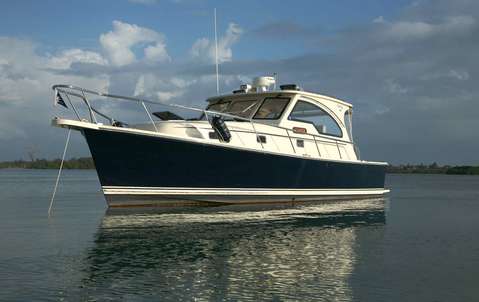
Forgot to mention an important thing. We stored our Pilot 34 out of the water. It always had a clean bottom and running grear. That will make at least one knot difference. Also, the mileage quoted is an average for the overall trip which is a real life scenario.

CPseudonym
Moderator Emeritus
Mainship got the lines right on that Pilot 34 IMO.
What was your opinion of the interior layout Don or David?
What was your opinion of the interior layout Don or David?
rclarke246
Senior Member
- Joined
- Mar 17, 2014
- Messages
- 450
- Location
- USA
- Vessel Name
- Lady Di
- Vessel Make
- 2012 Beneteau Swift Trawler 44
bligh
Guru
And we can have another thread about unicorns and gnomes too!Such as Benneteau, Sabreline, Mainship, etc.
Nomad Willy
Guru
Marin,
Yes I can see Ray Hunt stands out all over that Eastbay. Very typical of his hulls. His pure form deep Vee is constant in it's deadrise and the Eastbay has the wider range of appeal warped bottom (gets flatter w less deadrise as one goes aft) but is still plenty deep for an excellent ride and lower power requirements.
Can hardly miss if you've got a Ray Hunt hull.
Yes I can see Ray Hunt stands out all over that Eastbay. Very typical of his hulls. His pure form deep Vee is constant in it's deadrise and the Eastbay has the wider range of appeal warped bottom (gets flatter w less deadrise as one goes aft) but is still plenty deep for an excellent ride and lower power requirements.
Can hardly miss if you've got a Ray Hunt hull.
markpierce
Master and Commander
- Joined
- Sep 25, 2010
- Messages
- 12,557
- Location
- USA
- Vessel Name
- Carquinez Coot
- Vessel Make
- penultimate Seahorse Marine Coot hull #6
Since the majority of threads discuss fast trawlers, it would make more sense to have a thread entitled "real trawlers" of the recreational kind, not that I'm recommending it. 
RT Firefly
Enigma
Greetings,
Mr. mp. Hmm...A thread entitled "real trawlers"? I sort of think that's been covered several times (too many IMO) already. "Real trawlers are about as contentious as "real anchors"....

Mr. mp. Hmm...A thread entitled "real trawlers"? I sort of think that's been covered several times (too many IMO) already. "Real trawlers are about as contentious as "real anchors"....

rclarke246
Senior Member
- Joined
- Mar 17, 2014
- Messages
- 450
- Location
- USA
- Vessel Name
- Lady Di
- Vessel Make
- 2012 Beneteau Swift Trawler 44
Fast, semi displacement trawlers (to use the trawler term loosely) are the norm today. Very few trawlers are round bottom pure displacement hulls. It is easier to note which are not semi displacement than those which are. Nordhavns, Krogens are two that are full displacement trawlers. Beneteaus, Mainships, Grand Banks, Sabres, Nordic Tugs, etc are all semi displacement.
Semi displacement hulls are less efficient than round bottom displacement hulls at displacement speeds. The angular lifting planes on a semi displacement hull jus
Semi displacement hulls have big engines to push them to 10 kts and above. But can you safely run those big engines slow and cruise at or below displacement speeds?
The question is controversial, but I believe that if you run the engine at enough power loading to keep the cooling water and oil at operating temperatures then you will not do any damage. Coincidently that power level is just about the rpm and power setting needed to reach displacement speed.
So I run the 370 hp Yanmar in my Mainship Pilot 34 at 1,600 rpm and it goes about 7 kts, just below displacement speed. BTW the accepted definition of displacement speed is 1.34 * sqrt(water line length).
Weight becomes a big factor in semi-displacement hull efficiency, mostly because you are using a lot more fuel than a displacement hull at all speeds and much more fuel the faster you go.
It is interesting to note the differences in a low cost, mass produced trawler like the Mainship Pilot 34 and a high end one like a MJM 34. The Mainship claims that the Pilot 34 weighs 15,000 lbs and the MJM claims that their 34Z weighs 10,600 lbs. The difference if is is real is mostly due to fiberglass layup techniques. MJM claims that their 34Z uses 30% less fuel than their competitors and I can believe it if their weight is correct.
Semi displacement trawlers come in several hull types: classic flybridge models like the Grand Banks; pilot house, tug style like the Nordic Tug and downeaster style hardtops like the Mainship Pilot 34. And lots of variations in between.
Learning a lot here. Had no idea that some GBs and Nordic Tugs were SD.
My Beneteau Swift 44 has 2 Volvo D4's/300 hp. I doubt that these would be classified as "big engines".
I have seen no cooling problems running at FD speed, which I suppose is less than 10 knots.
At 1,250 RPM's she'll make 8 kn. total burn 3.6 GPH. We typically run around 2,850 RPM's, making around 17 kn., burning 19 GPH. WOT is 3,600 / 24 kn.
At around 25,000 lbs. (light) with a huge flybridge it makes sense that we're in for an uncomfortable ride in anything but a following sea.
Will find out as we get more experience with her, but I'm pretty sure that in rough conditions we'll be moving slowly until we can get tied up.
Mostly just asking. Agree?
Attachments
manyboats posts a nice PIX below showing a FD hull at about max speed. Notice the large stern wave and depressed water midships. You cant see it but there should be a wave forward. That wavelength the same as hull length is what limits speed. To go faster it would have to climb over the bow wave.
PS that in not a very efficient speed because of all the wave making despite the smooth stern water flow.

PS that in not a very efficient speed because of all the wave making despite the smooth stern water flow.
Learning a lot here. Had no idea that some GBs and Nordic Tugs were SD.
I know the comment above was from last year, but in case the poster is reading, ALL GBs except the latest models are semi-planing (I prefer this term to semi-displacement after reading naval architect Tom Fexas' reasons why semi-planing is the more accurate term). All of them-- GB32, 36, 42, 46, 48, 49, and 52-- use the same Kenneth Smith-designed hull shape from 1964 or thereabouts.
Only the latest models-- the GB44 aka 47, and the GB41 with the pod drives-- have new, planing (sort of) hull designs.
The Eastbay, while manufactured by the company now known as Grand Banks (formerly American Marine), is its own brand with its own model lineup. As such, Eastbays are not Grand Banks. Nor are Aleutians, the Grand Banks company's "big boat" model that is available in several sizes.
The Eastbay, while manufactured by the company now known as Grand Banks (formerly American Marine), is its own brand with its own model lineup. As such, Eastbays are not Grand Banks. Nor are Aleutians, the Grand Banks company's "big boat" model that is available in several sizes.
Then why do they have Grand Banks labels and are built by Grand Banks and marketed by them? I know your point is that they're departures from what is now known as the Heritage models.
21/22K lbs loaded; 34' Tollycraft tri cabin twin screw travels really well and comfortable at:
5 nmph, 6.5 to 7 nmph, 16 to 17 nmph and 21 to 22 nmph (WOT).
Gph respectively:
2.75 + nmpg (running only one screw), 1.75 to2 nmpg (running twins), 1 +/- nmpg at planing cruise, ??? nmpg (at WOT- never spend time to get a consumption reading there)
Talking all we want regarding boats and boat bottoms... it's been my experience... FD is fine for some. For me, regarding mid sized pleasure cruisers - SD and FP is the way to go, for too many reasons to list here!
5 nmph, 6.5 to 7 nmph, 16 to 17 nmph and 21 to 22 nmph (WOT).
Gph respectively:
2.75 + nmpg (running only one screw), 1.75 to2 nmpg (running twins), 1 +/- nmpg at planing cruise, ??? nmpg (at WOT- never spend time to get a consumption reading there)
Talking all we want regarding boats and boat bottoms... it's been my experience... FD is fine for some. For me, regarding mid sized pleasure cruisers - SD and FP is the way to go, for too many reasons to list here!
Attachments
When I find myself in one of these discussions, I prefer to avoid the great arguments on hull design, but prefer to look at the results. There are the 8-10 knot boats. Then those from 12-20 knots. Then those above. And a good many of the boats here fit in the two slower groups. When it comes to separating the 18 knot boats and the 24 knot and talking SD I also prefer the semi-planing term) vs. Planing, talking hull design gets quite confusing as the only difference in some of those boats in horsepower. Give me enough HP on any SD and I'll be planing.


